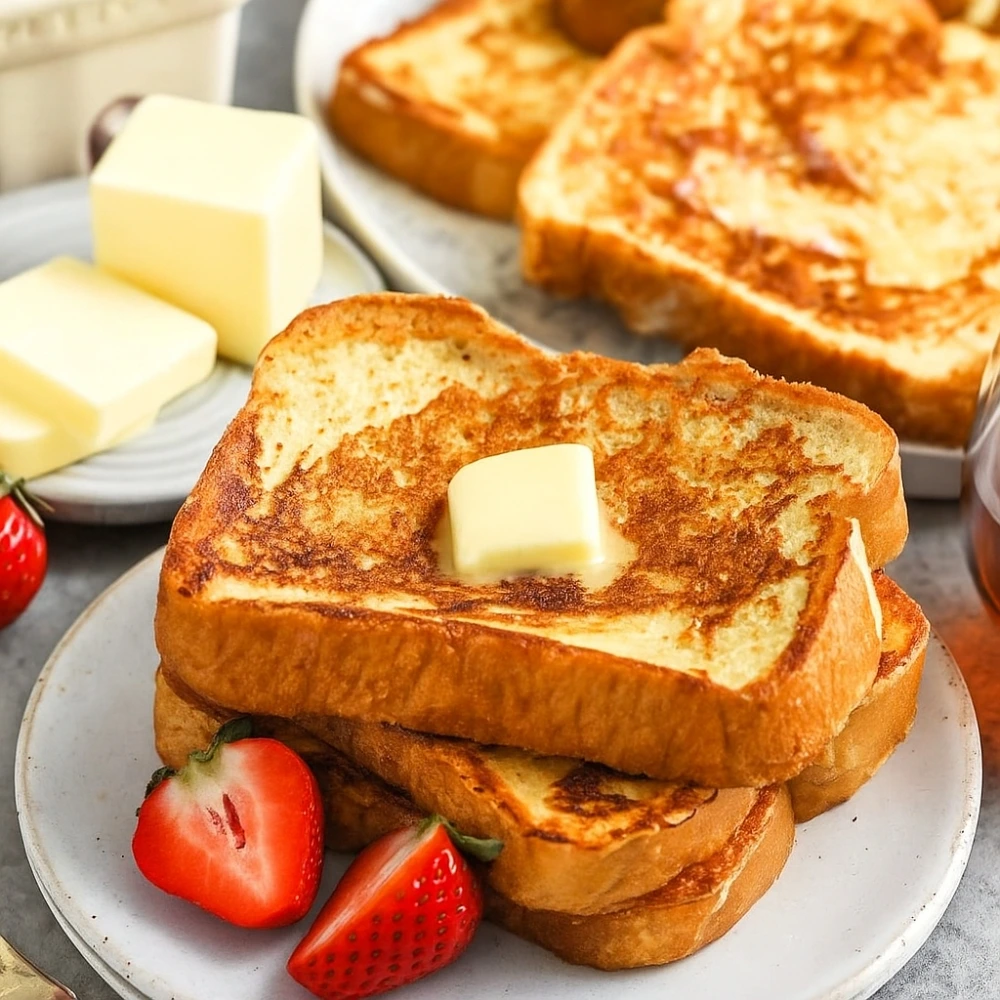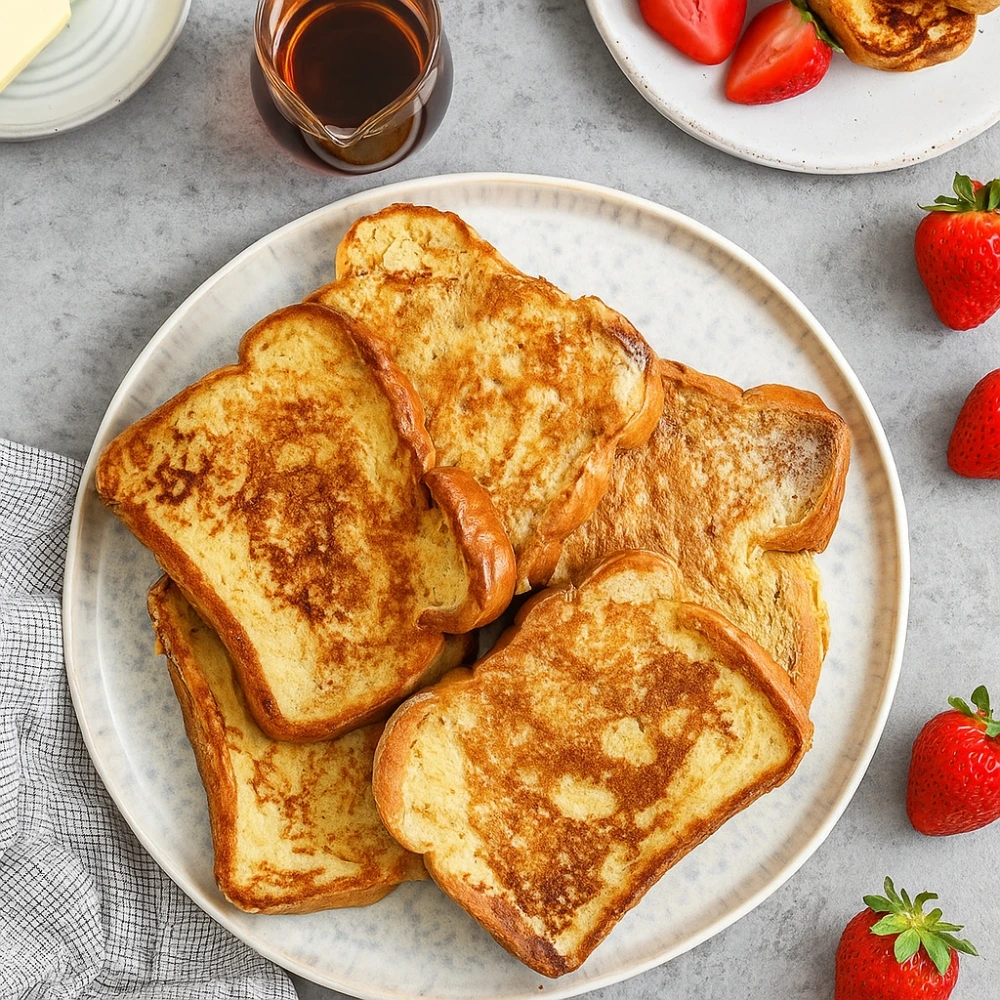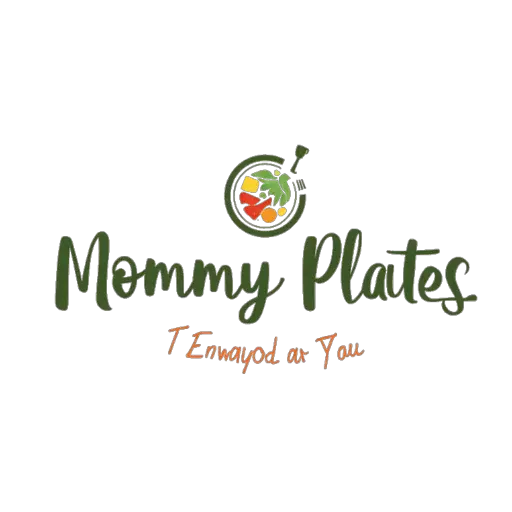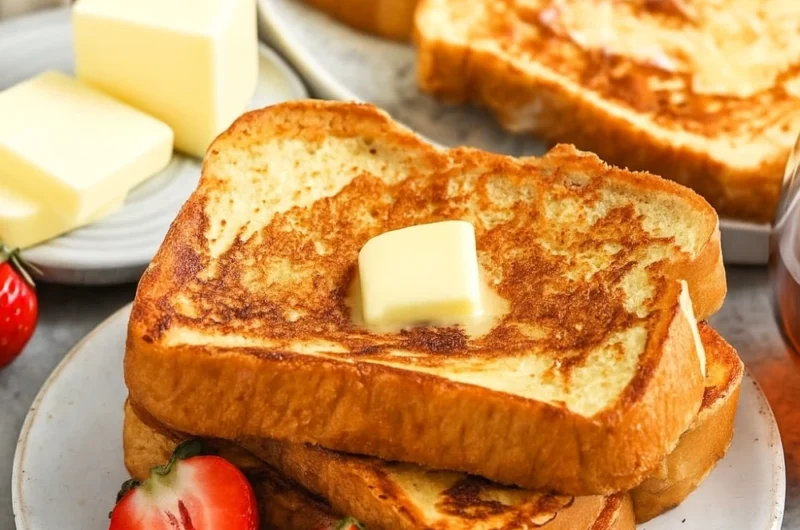The Best Fluffy Pancakes recipe you will fall in love with. Full of tips and tricks to help you make the best pancakes.
Guide to Perfect French Toast (Never Soggy, Guaranteed!)

We’ve all been there: the sad, soggy, eggy slice of bread that was supposed to be a glorious French toast breakfast but instead resembles a disappointing custard disaster. You follow a recipe to the letter, yet somehow end up with either burnt exteriors hiding raw centers or mushy, flavorless disappointments that fall apart on your fork.
This guide will not only give you a flawless French toast recipe but will also teach you the why behind each step, ensuring you make perfect, golden, custardy French toast every single time. After testing over 20 combinations of bread types, custard ratios, and cooking techniques, I’ve cracked the code to breakfast perfection.
Why This Recipe is The Best
Here’s what makes this French toast method superior:
• The Perfect Custard Ratio: We reveal the ideal egg-to-dairy ratio (1:3) for a rich custard that penetrates without creating sogginess • The Bread Breakdown: Learn exactly which bread works best and why staleness is your secret weapon • The Secret Ingredient: A touch of orange zest that adds incredible depth without overpowering the classic flavors • The Double-Temperature Technique: Our method for an extra-crispy exterior and a soft, creamy interior
The Ingredient Deep Dive: Building Your French Toast Foundation
Bread: The Foundation of Excellence
The Science of Stale Bread
Day-old bread isn’t just acceptable for French toast—it’s essential. Fresh bread contains too much moisture and will disintegrate when soaked in custard. Stale bread has a firmer structure that absorbs the egg mixture without falling apart, creating that perfect balance of crispy exterior and custardy center.
Best Breads for French Toast
| Bread Type | Pros | Cons | Best For |
|---|---|---|---|
| Brioche | Rich, buttery flavor; absorbs custard beautifully | Higher cost; very soft texture | Special occasions, indulgent breakfasts |
| Challah | Fluffy, absorbent; slightly sweet | Can be expensive; not always available | Weekend brunches, holiday breakfasts |
| Texas Toast | Thick, sturdy; holds up well to soaking | Less flavor complexity | Hearty appetites, stuffed variations |
| Sourdough | Tangy flavor; excellent structure | Sourness may compete with toppings | Adult palates, savory variations |
The Custard: Your Liquid Gold
Eggs & Dairy Ratio: The Science
The perfect French toast custard uses a 1:3 ratio—one egg to three tablespoons of dairy. Too much egg creates scrambled eggs on your bread’s surface. Too much milk makes soggy, flavorless toast. This ratio creates a custard that coats completely while maintaining structural integrity.
Fat is Flavor: Choosing Your Dairy
- Whole Milk: Creates lighter, more delicate French toast
- Heavy Cream: Produces rich, decadent results with superior browning
- Half-and-Half: The perfect middle ground for everyday indulgence
Flavor & Sweetness: The Finishing Touches
Sugar Selection Impact:
- Granulated Sugar: Clean sweetness, promotes even browning
- Brown Sugar: Adds molasses depth, creates slightly darker color
- Maple Syrup: Integrates beautifully, adds complex sweetness
Essential Aromatics:
- Cinnamon: Use Ceylon for delicate flavor, Cassia for bold warmth
- Nutmeg: A pinch adds sophisticated depth
- Pure Vanilla Extract: Never artificial—it makes a noticeable difference
- Secret Ingredient: Fresh orange zest brightens the entire dish
Step-by-Step Instructions: The Visual Walkthrough
The Perfect French Toast Method
Ingredients:
- 8 slices day-old brioche or challah, 1-inch thick
- 4 large eggs
- 3/4 cup whole milk
- 2 tablespoons granulated sugar
- 1 teaspoon pure vanilla extract
- 1/2 teaspoon ground cinnamon
- 1/4 teaspoon freshly grated nutmeg
- Zest of 1 orange
- Pinch of salt
- 2 tablespoons butter
- 1 tablespoon neutral oil
Instructions:
- Create the Perfect Custard: Whisk eggs thoroughly in a shallow dish until completely smooth. Add milk, sugar, vanilla, cinnamon, nutmeg, orange zest, and salt. Whisk until sugar dissolves completely—no grittiness should remain.
- Prepare Your Cooking Surface: Heat a large skillet or griddle over medium-low heat. Add butter and oil—the combination prevents burning while promoting golden browning.
- The Strategic Dip: Dip each bread slice into custard for exactly 3-4 seconds per side. The bread should be moistened but not saturated. Excess custard creates sogginess.
- The Golden Cook: Place dipped bread immediately into the hot pan. Cook for 2-3 minutes until golden brown, then flip carefully. Cook another 2-3 minutes until the second side matches.
- The Final Touch: Transfer to a 200°F oven if making multiple batches to keep warm and crispy.
Common Problems & Solutions: Troubleshooting Your French Toast
“Why is my French toast soggy?”
Solution: You’re over-soaking the bread, using fresh bread, or your custard ratio is off. Stick to the 3-4 second dip rule and use day-old bread.
“Why is my French toast eggy?”
Solution: Your custard wasn’t fully whisked, creating egg pockets, or you used too much egg. Whisk thoroughly and follow the 1:3 ratio.
“How do I keep my French toast from burning?”
Solution: Use medium-low heat and the butter-oil combination. High heat burns the outside before the inside cooks through.
“My French toast is bland—what’s wrong?”
Solution: You’re not using enough aromatics or quality ingredients. Don’t skip the vanilla, and use real spices, not pre-ground powder that’s lost its potency.

Variations & Customizations: Expanding Your Breakfast Repertoire
Stuffed French Toast
Create a pocket in thick bread slices and fill with cream cheese mixed with fresh berries or Nutella for an indulgent twist.
Savory French Toast
Replace sugar with herbs like thyme and chives, add grated parmesan to the custard, and top with a fried egg and crispy bacon.
Dietary Variations
Gluten-Free French Toast:
- Use thick gluten-free bread (let it go stale for best results)
- Increase custard ingredients by 25% as gluten-free bread absorbs more liquid
- Cook slightly longer at lower heat
Vegan French Toast:
- Replace eggs with 1/4 cup silken tofu + 1 tablespoon ground flaxseed
- Use unsweetened plant milk (oat milk works exceptionally well)
- Add 1 tablespoon nutritional yeast for richness
Serving, Storing, & Reheating: Maximizing Your French Toast Experience
The Ultimate Toppings Bar
Classic Options:
- Pure maple syrup (Grade A Dark Robust)
- Fresh berries (strawberries, blueberries, raspberries)
- Powdered sugar dusting
- Whipped cream or crème fraîche
Gourmet Additions:
- Caramelized bananas with pecans
- Lemon curd with fresh mint
- Mascarpone with honey drizzle
- Chocolate ganache with sea salt
Storage & Reheating
Refrigerator Storage: Store leftover French toast in the refrigerator for up to 3 days in an airtight container.
Freezer Storage: Freeze individual slices on a baking sheet, then transfer to freezer bags. Keeps for up to 2 months.
Reheating Methods:
- Best: Oven at 350°F for 5-7 minutes
- Good: Toaster oven on medium setting
- Avoid: Microwave (creates sogginess)
Expert FAQ: Your French Toast Questions Answered
Can I make French toast ahead of time?
Yes! Prepare the custard-soaked bread and refrigerate overnight. This actually improves flavor penetration. Cook fresh in the morning for best results.
What’s the best pan for French toast?
A heavy-bottomed skillet or cast-iron pan distributes heat evenly, preventing hot spots that cause uneven browning. Non-stick is acceptable but won’t create the same golden crust.
Can I use fresh bread for French toast?
Fresh bread can work if it’s very sturdy (like thick Texas toast), but day-old bread consistently produces superior results. If using fresh bread, toast it lightly first.
How do I know when French toast is done?
The exterior should be golden brown and crispy, while the center should be set but still slightly custardy. Internal temperature should reach 160°F.
Why does restaurant French toast taste different?
Restaurants often use brioche or challah, cook on well-seasoned griddles, and may add extra butter or cream to their custard. They also serve immediately at peak temperature.
The Science Behind Perfect French Toast: Understanding the Magic
French toast success relies on the Maillard reaction—the chemical process that creates golden browning and complex flavors. This reaction occurs between amino acids and sugars when heated, which is why the right custard ratio and cooking temperature are crucial.
The coagulation of proteins in the egg custard creates the structure that holds everything together, while the gelatinization of starches in the bread creates that perfect tender interior.
Understanding these processes helps you troubleshoot issues and adapt the recipe to your preferences. Temperature control becomes less mysterious when you know you’re managing chemical reactions, not just following steps.
Final Thoughts: Your French Toast Journey
Perfect French toast isn’t about following a recipe blindly—it’s about understanding the principles behind each step. With this knowledge, you can adapt the technique to any bread, any dietary restriction, and any flavor preference while maintaining those essential qualities: crispy exterior, custardy interior, and rich, satisfying flavor.
Remember, cooking is both science and art. Use these guidelines as your foundation, then experiment with confidence. Your perfect French toast awaits, and it will never be soggy again.
Pro Tip: Keep a notebook of your variations and results. French toast mastery comes through practice, and documenting your successes helps you replicate them consistently.
Ready to elevate your breakfast game even further? Try our [Homemade Maple Syrup Guide] or discover [The Ultimate Pancake Techniques] for a complete morning feast that will impress family and friends alike.
Guide to Perfect French Toast (Never Soggy, Guaranteed!)
Course: BreakfastCuisine: American, French4
servings10
minutes10
minutes290
kcalIngredients
4 slices of thick bread (e.g., brioche or challah)
2 large eggs
½ cup milk
1 tsp vanilla extract
½ tsp ground cinnamon
1 tbsp sugar (optional)
Butter or oil for frying
Maple syrup, powdered sugar, and berries for serving (optional)
Directions
- In a shallow bowl, whisk together eggs, milk, vanilla, cinnamon, and sugar.
- Dip each slice of bread into the mixture, coating both sides well.
- Heat butter or oil in a skillet over medium heat.
- Cook each slice for about 2–3 minutes per side, or until golden brown.
- Serve hot with maple syrup, fresh berries, or a dusting of powdered sugar.

